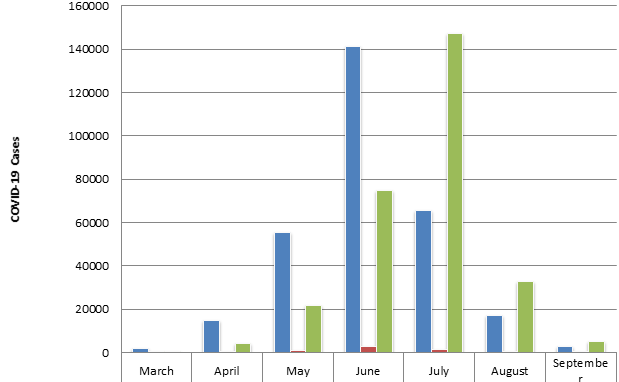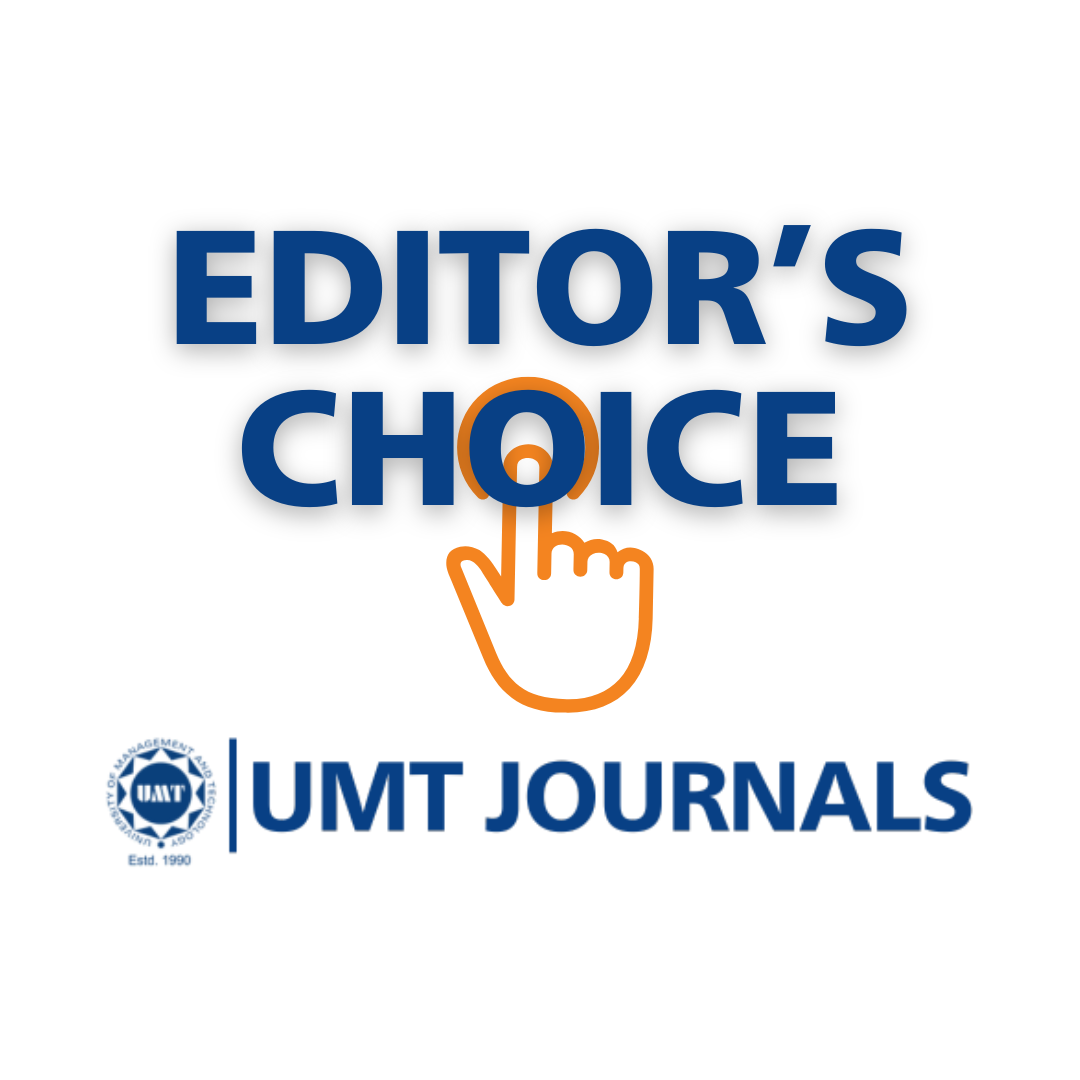COVID-19 in Pakistan: Current Practices and Associated Risks
Abstract
 Abstract Views: 289
Abstract Views: 289
Seven coronaviruses were identified previously and these were known to infect human beings. The eighth human coronavirus (nCoV-2019) surfaced in Wuhan, China at the end of the year 2019, exhibiting symptoms of pneumonia and other respiratory problems. As of September 7, 2020, 27 million people have been infected with COVID-19 and more than 900,000 have lost their lives. In Pakistan, the tally of COVID-19 infected cases stands at 298,509 and 6,342 people have died. Government of Pakistan has devised “The National Action Plan for the Corona Virus Disease (COVID-19) Pakistan” to efficiently tackle the pandemic. Many hurdles stand in the way of Pakistan fighting against the COVID-19 pandemic, effectively. Poverty and a low literacy rate are major obstacles in containing the COVID-19 transmission in Pakistan. Pakistan’s healthcare infrastructure is not fully equipped to deal with the pandemic. It is constrained by a very limited healthcare budget, small number of healthcare personnel and limited equipment. The number of tests conducted is very low which cannot give a proper insight into the actual incidence of COVID-19. Thus, it can be concluded that Pakistan, within the given facilities and predictions, is incapable of flattening the curve but the catastrophe can be avoided by taking proper measures in time.
Copyright (c) The Author
Downloads
References
. Weiss SR, Navas S-M. Coronavirus pathogenesis and the emerging pathogen severe acute respiratory syndrome coronavirus. Microbiol Mol Biol Rev. 2005;69(4): 635–664. DOI: 10.1128/MMBR.69.4.635-664.2005
. Langereis MA, van Vliet AL, Boot W, de Groot RJ. Attachment of mouse hepatitis virus to O-acetylated sialic acid is mediated by hemagglutinin-esterase and not by the spike protein. J Virol. 2010;84(17): 8970–8974.
. Lai MMC, Perlman S, Anderson LJ. Coronaviridae. In: Fields BN, Knipe DM, Howley PM, eds. Fields Virology. Philadelphia: Wolters Kluwer Health; 2007:1305–1318.
. Lai MM, Cavanagh D. The molecular biology of coronaviruses. Adv Virus Res. 1997;48: 1–100. https://www.ncbi.nlm.nih.gov/pmc/articles/PMC7130985/
. Reed SE. The behaviour of recent isolates of human respiratory coronavirus in vitro and in volunteers: evidence of heterogeneity among 229E‐related strains. J Me Virol. 1984;13(2): 179–192. https://pubmed.ncbi.nlm.nih.gov/6319590/
. World Health Organization. Statement on the second meeting of the International Health Regulations (2005) Emergency Committee regarding the outbreak of novel coronavirus (2019-nCoV). https://www.who.int/news-room/detail/30-01-2020-statement-on-the-second-meeting-of-the-international-health-regulations-(2005)-emergency-committee-regarding-the-outbreak-of-novel-coronavirus-(2019-ncov). Accessed January 31, 2020
. Su S, Wong G, Shi W, et al. Epidemiology, genetic recombination, and pathogenesis of coronaviruses. Trends Microbiol. 2016;24(6): 490–502. https://pubmed.ncbi.nlm.nih.gov/27012512/
. Centre of Disease Control. 2019 Novel Coronavirus, Wuhan, China. https://www.cdc.gov/coronavirus/2019-nCoV/summary.html. Accessed January 28, 2020.
. Shi Z-L, Zhou P, Yang X-L, et al. Discovery of a novel coronavirus associated with the recent pneumonia outbreak in humans and its potential bat origin. BioRxiv. In press. https://www.biorxiv.org/content/10.1101/2020.01.22.914952v2
. Poon L, Chu D, Chan K, et al. Identification of a novel coronavirus in bats. J Virolog. 2005;79(4): 2001–2009.
. Chan JF-W, Yuan S, Kok K-H, et al. A familial cluster of pneumonia associated with the 2019 novel coronavirus indicating person-to-person transmission: a study of a family cluster. The Lancet. 2020;395(10223): 514–523. https://www.thelancet.com/journals/lancet/article/PIIS0140-6736(20)30154-9/fulltext
. National Center for Immunization and Respiratory Diseases (NCIRD) DoVD. Coronavirus disease 2019 (COVID-19) situation summary. Centers for Disease Control and Prevention. https://www.cdc.gov/coronavirus/2019-ncov/cases-updates/summary.html?CDC_AA_refVal=https%3A%2F%2Fwww.cdc.gov%2Fcoronavirus%2F2019-ncov%2Fsummary.html. Accessed March 31, 2020.
. World Health Organization. Coronavirus disease 2019 (COVID-19): situation report-130. https://www.who.int/docs/default-source/coronaviruse/situation-reports/20200529-covid-19-sitrep-130.pdf?sfvrsn=bf7e7f0c_4
. World Health Organization. Coronavirus disease (COVID-19): weekly epidemiological update. https://www.who.int/docs/default-source/coronaviruse/situation-reports/20200907-weekly-epi-update-4.pdf?sfvrsn=f5f607ee_2. Accessed September 7, 2020.
. National Institute of Health (NIH) - Pakistan. Daily situation report-Pakistan: COVID-19 Updated 31st March' 2020. https://www.nih.org.pk/wp-content/uploads/2020/03/COVID-19-Daily-Updated-SitRep-31-Mar-2020.pdf. Accessed March 31, 2020.
. National Institute of Health (NIH) - Pakistan. COVID-19 Dashboard-Government of Pakistan. http://covid.gov.pk/stats/pakistan. Accessed September 09, 2020.
. Khan Z, Muhammad K, Ahmed A, Rahman H. Coronavirus outbreaks: prevention and management recommendations. Drugs Ther Perspect. 2020;March: 1–3. https://www.ncbi.nlm.nih.gov/pmc/articles/PMC7095077/
. National Institute of Health (NIH) - Pakistan. National Action Plan for Corona Virus Disease (COVID-19) Pakistan. https://www.nih.org.pk/wp-content/uploads/2020/03/COVID-19-NAP-V2-13-March-2020.pdf
. Saqlain M, Munir MM, Ahmed A, Tahir AH, Kamran S. Is Pakistan prepared to tackle the coronavirus epidemic? Drugs Ther Perspect. 2020;March: 1–2. https://www.ncbi.nlm.nih.gov/pmc/articles/PMC7095264/
. National Institute of Health (NIH) - Pakistan. List of hospitals province-wise with isolation facilities. https://www.nih.org.pk/wp-content/uploads/2020/03/List-of-Province-wise-COVID-19-Hospital-Isolation-Wards-Pakistan.pdf. Accessed May 31, 2020.
. Arif GM, Farooq S. Rural poverty dynamics in Pakistan: evidence from three waves of the panel survey. Pak Dev Rev. 2014;53(2): 71–98. https://www.researchgate.net/publication/265084416_Dynamics_of_Rural_Poverty_in_Pakistan_Evidence_from_Three_Waves_of_the_Panel_Survey
. Guy JS, Breslin JJ, Breuhaus B, Vivrette S, Smith LG. Characterization of a coronavirus isolated from a diarrheic foal. J Clin Microbiol. 2000;38(12): 4523–4526.
. National Institute of Health (NIH) - Pakistan. Weekly field epidemiology report. https://www.nih.org.pk/wpcontent/uploads/2020/09/35-FELTP-Pakistan-Weekly-Epidemiological-Report-Aug-23-29-2020.pdf. Accessed September 07, 2020.

Copyright (c) 2020 Aleena Haqqi

This work is licensed under a Creative Commons Attribution 4.0 International License.
BSR follows an open-access publishing policy and full text of all published articles is available free, immediately upon publication of an issue. The journal’s contents are published and distributed under the terms of the Creative Commons Attribution 4.0 International (CC-BY 4.0) license. Thus, the work submitted to the journal implies that it is original, unpublished work of the authors (neither published previously nor accepted/under consideration for publication elsewhere). On acceptance of a manuscript for publication, a corresponding author on the behalf of all co-authors of the manuscript will sign and submit a completed the Copyright and Author Consent Form.









